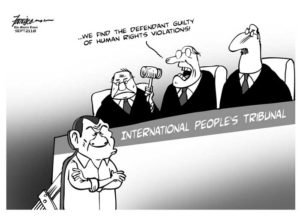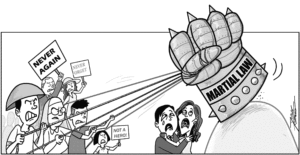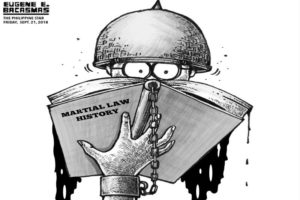OP ED EDITORIAL & CARTOONS: MANILA- Mining a tragedy
7.1. Pushing on a string – Daily Tribune – A better sanctuary


.
7.2. Manila Bulletin –CHANGING WORLD –How agribusiness can eradicate poverty By DR. BERNARDO M. VILLEGAS

Whatever we do to improve the infrastructures for the urban centers of the Philippines through the “Build, Build, Build” program, such as building modern airports, subways, rapid trains, and tollroads, we will not make any significant dent on mass poverty because poverty is fundamentally a rural phenomenon in our country. Development has to happen in the countryside, and especially in the agricultural sector. It is providential that Malaysia is now in the news because of the recent dramatic return of the oldest head of state in the world today in the person of Prime Minister Mahathir who is over 90 years of age. It is the example of Malaysia that can inspire us to implement one of the most effective solutions to rural poverty that the agribusiness sector can offer. Dr. Rolando Dy describes in great detail this outstanding example of an agribusiness model that helped Malaysia reduce poverty from the high of 52.4 percent in 1970 to practically zero today. How did they do it? Let me summarize Dr. Dy’s article entitled “The Dramatic Transformation of Rural Malaysia.”
.
7.3. The Manila Standard – Mining a tragedy

7.4. The Manila Times – INTERNATIONAL PEOPLE’S TRIBUNAL


7.6 The Philippine Star – Revisiting martial law


8.0. The Straits Times

The Straits Times says:
Wide arsenal needed to fight fake news
.
There is no shortage of examples from around the world to illustrate just how live, serious and insidious the threat of fake news can be. Individuals, groups and states have sought to generate and disseminate false information to advance their own interests and undermine those who are opposed to or at odds with them. The report of the Select Committee on Deliberate Online Falsehoods, released on Thursday, noted that such falsehoods have been aimed at discrediting leaders, swaying election outcomes, and sowing discord. These have also been used to spark tensions among ethnic groups and between residents and immigrants. The deliberate spread of falsehoods is not new. States large and small have weaponised information throughout history. But technology has magnified untruths and amplified their reach.
Social media platforms such as Facebook, Twitter and WhatsApp have aided – and in some cases abetted – their spread. The report underlined how this has become a strategically attractive option for states to spread disinformation, especially as research suggests that falsehoods have the upper hand over facts in today’s environment. Singapore has been a target of foreign, state-sponsored information warfare. This is expected to continue as agencies and states seek to influence policies here. Such assaults are part of a spectrum of non-military tools and were seen in recent cyber attacks, including the hacking of SingHealth’s databases. In other instances, a foreign country is known to have used news articles and social media to influence a segment of Singapore society to come round to accepting its actions globally. Foreign actors may well attempt to stir tensions during periods of leadership transition or at elections – directly, or by exploiting the ready availability of cyber armies and troll farms in the region. They may also use these to disrupt Singapore’s cohesion and multiracial make-up.
TO READ THE FULL ARTICLE: https://www.straitstimes.com/opinion/st-editorial/wide-arsenal-needed-to-fight-fake-news
.
 All photographs, news, editorials, opinions, information, data, others have been taken from the Internet ..aseanews.net | [email protected] |.For comments, Email to :D’Equalizer | [email protected] | Contributor
All photographs, news, editorials, opinions, information, data, others have been taken from the Internet ..aseanews.net | [email protected] |.For comments, Email to :D’Equalizer | [email protected] | Contributor









